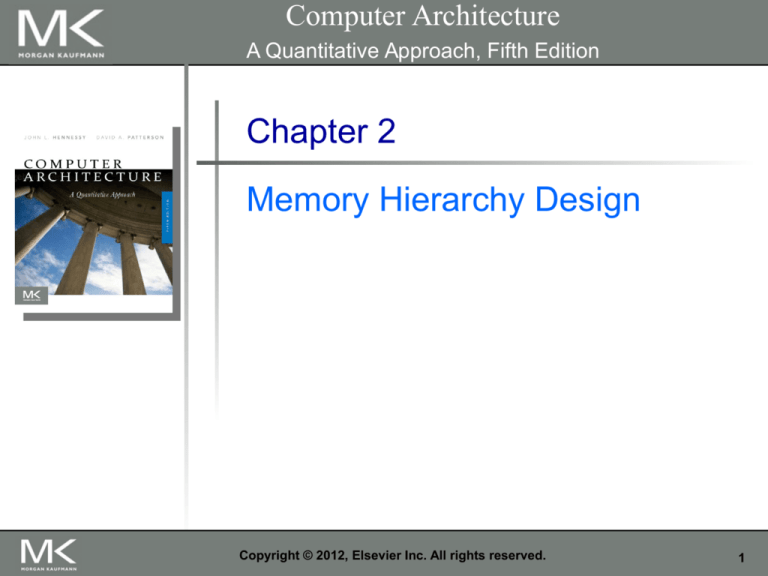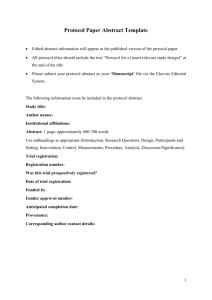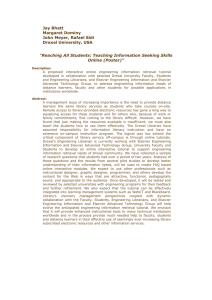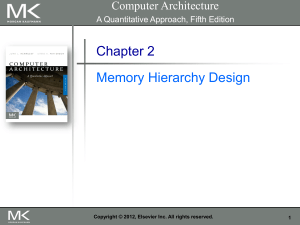
Computer Architecture
A Quantitative Approach, Fifth Edition
Chapter 2
Memory Hierarchy Design
Copyright © 2012, Elsevier Inc. All rights reserved.
1
Introduction
Introduction
Programmers want unlimited amounts of memory with
low latency
Fast memory technology is more expensive per bit than
slower memory
Solution: organize memory system into a hierarchy
Entire addressable memory space available in largest, slowest
memory
Incrementally smaller and faster memories, each containing a
subset of the memory below it, proceed in steps up toward the
processor
Temporal and spatial locality insures that nearly all
references can be found in smaller memories
Gives the allusion of a large, fast memory being presented to the
processor
Copyright © 2012, Elsevier Inc. All rights reserved.
2
Copyright © 2012, Elsevier Inc. All rights reserved.
Introduction
Memory Hierarchy
3
Copyright © 2012, Elsevier Inc. All rights reserved.
Introduction
Memory Performance Gap
4
Memory hierarchy design becomes more crucial
with recent multi-core processors:
Introduction
Memory Hierarchy Design
Aggregate peak bandwidth grows with # cores:
Intel Core i7 can generate two references per core per clock
Four cores and 3.2 GHz clock
25.6 billion 64-bit data references/second +
12.8 billion 128-bit instruction references
= 409.6 GB/s!
DRAM bandwidth is only 6% of this (25 GB/s)
Requires:
Multi-port, pipelined caches
Two levels of cache per core
Shared third-level cache on chip
Copyright © 2012, Elsevier Inc. All rights reserved.
5
High-end microprocessors have >10 MB on-chip
cache
Introduction
Performance and Power
Consumes large amount of area and power budget
Copyright © 2012, Elsevier Inc. All rights reserved.
6
Introduction
Memory Hierarchy Basics
Note that speculative and multithreaded
processors may execute other instructions
during a miss
Reduces performance impact of misses
Copyright © 2012, Elsevier Inc. All rights reserved.
10
Six basic cache optimizations:
Introduction
Memory Hierarchy Basics
Larger block size
Reduces compulsory misses
Increases capacity and conflict misses, increases miss penalty
Larger total cache capacity to reduce miss rate
Increases hit time, increases power consumption
Higher associativity
Reduces conflict misses
Increases hit time, increases power consumption
Higher number of cache levels
Reduces overall memory access time
Giving priority to read misses over writes
Reduces miss penalty
Avoiding address translation in cache indexing
Reduces hit time
Copyright © 2012, Elsevier Inc. All rights reserved.
11
Small and simple first level caches
Critical timing path:
addressing tag memory, then
comparing tags, then
selecting correct set
Advanced Optimizations
Ten Advanced Optimizations
Direct-mapped caches can overlap tag compare and
transmission of data
Lower associativity reduces power because fewer
cache lines are accessed
Copyright © 2012, Elsevier Inc. All rights reserved.
12
Advanced Optimizations
L1 Size and Associativity
Access time vs. size and associativity
Copyright © 2012, Elsevier Inc. All rights reserved.
13
Advanced Optimizations
L1 Size and Associativity
Energy per read vs. size and associativity
Copyright © 2012, Elsevier Inc. All rights reserved.
14
To improve hit time, predict the way to pre-set
mux
Mis-prediction gives longer hit time
Prediction accuracy
Advanced Optimizations
Way Prediction
> 90% for two-way
> 80% for four-way
I-cache has better accuracy than D-cache
First used on MIPS R10000 in mid-90s
Used on ARM Cortex-A8
Extend to predict block as well
“Way selection”
Increases mis-prediction penalty
Copyright © 2012, Elsevier Inc. All rights reserved.
15
Pipeline cache access to improve bandwidth
Examples:
Pentium: 1 cycle
Pentium Pro – Pentium III: 2 cycles
Pentium 4 – Core i7: 4 cycles
Advanced Optimizations
Pipelining Cache
Increases branch mis-prediction penalty
Makes it easier to increase associativity
Copyright © 2012, Elsevier Inc. All rights reserved.
16
Allow hits before
previous misses
complete
“Hit under miss”
“Hit under multiple
miss”
Advanced Optimizations
Nonblocking Caches
L2 must support this
In general,
processors can hide
L1 miss penalty but
not L2 miss penalty
Copyright © 2012, Elsevier Inc. All rights reserved.
17
Organize cache as independent banks to
support simultaneous access
ARM Cortex-A8 supports 1-4 banks for L2
Intel i7 supports 4 banks for L1 and 8 banks for L2
Advanced Optimizations
Multibanked Caches
Interleave banks according to block address
Copyright © 2012, Elsevier Inc. All rights reserved.
18
Critical word first
Request missed word from memory first
Send it to the processor as soon as it arrives
Early restart
Advanced Optimizations
Critical Word First, Early Restart
Request words in normal order
Send missed work to the processor as soon as it
arrives
Effectiveness of these strategies depends on
block size and likelihood of another access to
the portion of the block that has not yet been
fetched
Copyright © 2012, Elsevier Inc. All rights reserved.
19
When storing to a block that is already pending in the
write buffer, update write buffer
Reduces stalls due to full write buffer
Do not apply to I/O addresses
Advanced Optimizations
Merging Write Buffer
No write
buffering
Write buffering
Copyright © 2012, Elsevier Inc. All rights reserved.
20
Loop Interchange
Swap nested loops to access memory in
sequential order
Advanced Optimizations
Compiler Optimizations
Blocking
Instead of accessing entire rows or columns,
subdivide matrices into blocks
Requires more memory accesses but improves
locality of accesses
Copyright © 2012, Elsevier Inc. All rights reserved.
21
Fetch two blocks on miss (include next
sequential block)
Advanced Optimizations
Hardware Prefetching
Pentium 4 Pre-fetching
Copyright © 2012, Elsevier Inc. All rights reserved.
22
Insert prefetch instructions before data is
needed
Non-faulting: prefetch doesn’t cause
exceptions
Advanced Optimizations
Compiler Prefetching
Register prefetch
Loads data into register
Cache prefetch
Loads data into cache
Combine with loop unrolling and software
pipelining
Copyright © 2012, Elsevier Inc. All rights reserved.
23
Copyright © 2012, Elsevier Inc. All rights reserved.
Advanced Optimizations
Summary
24
Performance metrics
Latency is concern of cache
Bandwidth is concern of multiprocessors and I/O
Access time
Memory Technology
Memory Technology
Time between read request and when desired word
arrives
Cycle time
Minimum time between unrelated requests to memory
DRAM used for main memory, SRAM used
for cache
Copyright © 2012, Elsevier Inc. All rights reserved.
25
SRAM
Requires low power to retain bit
Requires 6 transistors/bit
Memory Technology
Memory Technology
DRAM
Must be re-written after being read
Must also be periodically refeshed
Every ~ 8 ms
Each row can be refreshed simultaneously
One transistor/bit
Address lines are multiplexed:
Upper half of address: row access strobe (RAS)
Lower half of address: column access strobe (CAS)
Copyright © 2012, Elsevier Inc. All rights reserved.
26
Amdahl:
Memory capacity should grow linearly with processor speed
Unfortunately, memory capacity and speed has not kept
pace with processors
Memory Technology
Memory Technology
Some optimizations:
Multiple accesses to same row
Synchronous DRAM
Added clock to DRAM interface
Burst mode with critical word first
Wider interfaces
Double data rate (DDR)
Multiple banks on each DRAM device
Copyright © 2012, Elsevier Inc. All rights reserved.
27
Copyright © 2012, Elsevier Inc. All rights reserved.
Memory Technology
Memory Optimizations
28
Copyright © 2012, Elsevier Inc. All rights reserved.
Memory Technology
Memory Optimizations
29
DDR:
DDR2
Lower power (2.5 V -> 1.8 V)
Higher clock rates (266 MHz, 333 MHz, 400 MHz)
Memory Technology
Memory Optimizations
DDR3
1.5 V
800 MHz
DDR4
1-1.2 V
1600 MHz
GDDR5 is graphics memory based on DDR3
Copyright © 2012, Elsevier Inc. All rights reserved.
30
Graphics memory:
Achieve 2-5 X bandwidth per DRAM vs. DDR3
Wider interfaces (32 vs. 16 bit)
Higher clock rate
Memory Technology
Memory Optimizations
Possible because they are attached via soldering instead of
socketted DIMM modules
Reducing power in SDRAMs:
Lower voltage
Low power mode (ignores clock, continues to
refresh)
Copyright © 2012, Elsevier Inc. All rights reserved.
31
Copyright © 2012, Elsevier Inc. All rights reserved.
Memory Technology
Memory Power Consumption
32
Type of EEPROM
Must be erased (in blocks) before being
overwritten
Non volatile
Limited number of write cycles
Cheaper than SDRAM, more expensive than
disk
Slower than SRAM, faster than disk
Copyright © 2012, Elsevier Inc. All rights reserved.
Memory Technology
Flash Memory
33
Memory is susceptible to cosmic rays
Soft errors: dynamic errors
Memory Technology
Memory Dependability
Detected and fixed by error correcting codes
(ECC)
Hard errors: permanent errors
Use sparse rows to replace defective rows
Chipkill: a RAID-like error recovery technique
Copyright © 2012, Elsevier Inc. All rights reserved.
34
Protection via virtual memory
Keeps processes in their own memory space
Role of architecture:
Provide user mode and supervisor mode
Protect certain aspects of CPU state
Provide mechanisms for switching between user
mode and supervisor mode
Provide mechanisms to limit memory accesses
Provide TLB to translate addresses
Copyright © 2012, Elsevier Inc. All rights reserved.
Virtual Memory and Virtual Machines
Virtual Memory
35
Supports isolation and security
Sharing a computer among many unrelated users
Enabled by raw speed of processors, making the
overhead more acceptable
Allows different ISAs and operating systems to be
presented to user programs
Virtual Memory and Virtual Machines
Virtual Machines
“System Virtual Machines”
SVM software is called “virtual machine monitor” or
“hypervisor”
Individual virtual machines run under the monitor are called
“guest VMs”
Copyright © 2012, Elsevier Inc. All rights reserved.
36
Each guest OS maintains its own set of page
tables
VMM adds a level of memory between physical
and virtual memory called “real memory”
VMM maintains shadow page table that maps
guest virtual addresses to physical addresses
Requires VMM to detect guest’s changes to its own page
table
Occurs naturally if accessing the page table pointer is a
privileged operation
Copyright © 2012, Elsevier Inc. All rights reserved.
Virtual Memory and Virtual Machines
Impact of VMs on Virtual Memory
37





